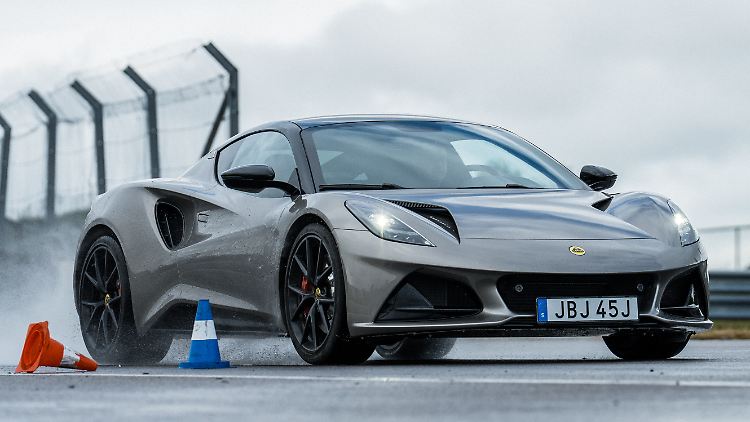Not particularly suitable for everyday use: Lotus Emira Turbo SE - with optional equipment as standard

The Lotus Emira Turbo SE has the design of a super sports car.
(Photo: Lotus)
Lotus has given the entry-level four-cylinder engine of its last combustion-engined model, the Emira, such a power boost that it surpasses the V6. This isn't the only paradox of this sports car.
AMG is putting Lotus customers in a difficult position with the Emira, the British company's last sports car with a combustion engine. And not because the Mercedes brand has designed a competing model. Rather, the 2.0-liter four-cylinder engine in the Lotus Emira Turbo SE, supplied from Affalterbach, now produces 294 kW/400 hp. This puts the previous entry-level engine on par with the 3.5-liter engine in the Emira V6. What's more, with 480 Newton meters of torque and 93 kilograms less curb weight, the little brother offers better performance with lower fuel consumption. With a starting price of €109,490, it's also €3,000 cheaper.

With 480 Newton meters of torque and 93 kilograms less curb weight, the little brother has better performance than the V6 model.
(Photo: Lotus)
Historically, the abbreviation "SE" at Lotus stood for "Special Equipment," meaning something like an optional extra. Since the Emira Turbo SE bears this abbreviation, the "Lotus Drivers Pack" is, ironically, part of its standard equipment. This means a carefully tuned sports suspension, reinforced, cross-drilled, and ventilated brake discs, and launch control are standard. The package is complemented by gray 20-inch alloy wheels with contrasting red brake calipers and an Alcantara headliner.
More horsepower, faster than beforeCompared to the First Edition Emira, which has been on sale since 2022, the four-cylinder engine, known to AMG as the M139, produces 40 hp more and boasts 50 Newton meters more torque. The eight-speed dual-clutch transmission also comes from Swabia. This combination accelerates the Emira Turbo SE from 0 to 100 km/h in four seconds and to a top speed of 291 km/h—16 km/h faster than before.

The Lotus Emira Turbo SE being tested on the race track.
(Photo: Lotus)
We had the opportunity to test the Emira Turbo SE in Sweden – around Gothenburg and on the Falkenberg Motorbana race track. The seating position in the two-seater, which is only 1.23 meters high, is extremely low. Due to the mid-engine position at the rear, the front end drops so steeply in front of the windshield for aerodynamic reasons that it's impossible to tell where it ends from behind the steering wheel.
Pad change noticeableThe steering responds directly and provides so much feedback that even a tire change on the highway can be felt in the steering wheel. While this provides precision on the racetrack, it can be quite annoying on long journeys. The Emira tends to follow ruts and bumps in the road. It almost feels like a lane departure warning system intervening—except that it veers off the track.

You sit low in the Lotus Emira Turbo SE.
(Photo: Lotus)
At high speeds, however, the British car is beyond reproach. At 200 km/h (124 mph), its aerodynamics generate 55 kilograms of downforce. At this speed, normal cars experience lift, which diminishes driving stability. The acoustics are quite respectable, considering the small displacement for a sports car. A full-bodied, sonorous sound accompanies the powerful acceleration. Driving at the speed limit on the highway will reduce fuel consumption to under ten liters.
Stable brakesOn the racetrack, the Emira Turbo SE is easy to control, even for amateur drivers. The brakes remain stable even after several fast laps. Three driving modes—from Touring to Sport to Track—allow you to gradually adjust the level of assistance provided by the electronic driving aids. This allows the sports car to be adapted to increasing experience.

The dual-clutch transmission is standard on the four-cylinder model; a manual transmission is not available.
(Photo: Lotus)
The question remains as to who the Emira V6 is for. According to Lotus, the big brother is even more geared towards the racetrack. Purists can also order it with a traditional manual transmission, an option not available with the Turbo. Therefore, buyers of the Turbo should enjoy the semi-automatic mode via shift paddles on the steering wheel. Because if Lotus one day discontinues the Emira and starts producing exclusively electric vehicles, an eight-speed dual-clutch transmission will also be history.
Lotus Emira Turbo SE - technical data
- Two-door compact class coupe
- Length: 4.41 meters, width: 1.90 meters (with exterior mirrors: 2.09 meters), height: 1.23 meters, wheelbase: 2.58 meters, trunk volume: 151 liters
- 2.0-liter petrol engine: 294 kW/400 hp, torque 480 Nm; rear-wheel drive, 8-speed dual-clutch transmission
- 0-100 km/h: 4.0 s, top speed: 291 km/h, fuel consumption: 9.192 l/100 km, CO₂ emissions: 208 g/km
- Price: 109,490 euros
Source: ntv.de, Martin Westerhoff, sp-x
n-tv.de





